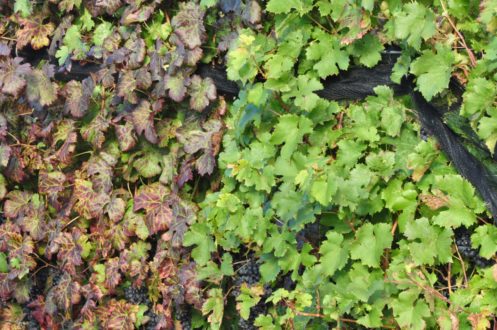Aug 22, 2017Grapevine leafroll associated virus addressed in Pennsylvania
As if winegrape growers don’t have enough challenges in this day and age, the effects of grapevine viruses have been taking on greater importance in eastern vineyards over the past several years.
Studies examining grapevine leafroll-associated viruses are developing a growing body of information that will be essential for vineyard managers to continue moving the eastern wine grape industry forward. Grape growers in the eastern United States need not feel they are the only ones with this disease management challenge (as is the case with many fungal diseases of grapes); grapevine leafroll-associated viruses (GLRaVs) are found in vineyards all over the world (Compendium of Grape Diseases).
This group of viruses causes a disease known as grapevine leafroll disease, and the association of symptoms with grapevine leafroll viruses was recognized over 80 years ago. As is the case with so many plant pathogens, the worldwide distribution of these viruses occurred as a result of increased movement of plant material/goods across the globe; the ever widening dissemination of infected planting stock (Compendium of grape diseases).
The effects of these leafroll viruses is most severe on – you guessed it – cultivars of V. vinifera, where the disease is known to greatly reduce yield, vine vegetative growth or vigor, and cold hardiness; a factor of critical importance for these cultivars grown in the northeastern United States. Grapevine leafroll disease can also delay fruit maturity, reduce color development in red grapes, and fruit quality (decreased soluble solids, increased titratable acidity) of V. vinifera grapes (Fuchs et al. 2009), which can negatively impact perceived wine quality.
The severity of the effects of leafroll viruses is dependent on a great number of factors such as grapevine cultivar, virus strain, climate, soil, cultural practices, stress factors, etc. So naturally, the severity of symptoms can vary from one season to the next (Compendium of Grape Diseases). With respect to cultivar, the effects of these viruses on Vitis interspecific hybrids and Vitis labrusca are generally considered to be less serious, but are also less well defined and studied.
Infection by leafroll viruses results in the degeneration of primary phloem tissues in grapevine shoots, leaves and clusters (Compendium of Grape Diseases). As one can imagine, this can have profound effects on all parts of the vine. Symptoms of the disease, which are generally most observable on V. vinifera, consist of cupping and discoloration of older leaves in late summer and fall.
On red fruited varieties, leaves of infected vines can display a distinct red coloration of the interveinal tissue, while veins remain green (Figure 1. Above, Grapevine Leafroll Disease on red fruited Vitis vinifera. The infected vine is on the left.). On white fruited varieties of V. vinifera, symptoms are less striking and leaves tend to look yellowish (chlorotic) and cupped (Figure 2). Leaf discoloration generally affects older leaves first, but these symptoms are not diagnostic of the disease, as they may be due to other causes such as nutrient deficiencies, water stress, and even crown gall. Analysis of grapevine tissues in the laboratory is the only way to confirm the presence (or absence) of these viruses.

Currently, there are about seven GLRaVs found in cultivated grapes, the most common being GLRaV-3. These viruses are easily spread over long distances through the movement of infected nursery stock, but can be spread (vectored) within the vineyard by mealybugs (Compendium of Grape Diseases). Unfortunately, there are no known sources of resistance to GLRaVs among Vitis species and they have been found in many cultivated grape varieties, including V. labrusca, Vitis interspecific hybrids, and V. vinifera.
Interest in grapevine leafroll disease and the extent of its effects has been growing in the eastern United States over the past ten years or so. Surveys conducted in New York, Ohio, and Virginia (Fuchs et al. 2009, Jones et al. 2015, Han et al. 2014), have provided confirmation of the presence of GLRaVs in commercial vineyards and have yielded important information necessary to the management of grapevine leafroll disease.
For example, infection by GLRaVs is permanent and infected vines must be destroyed to reduce the incidence of grapevine leafroll disease. Therefore, management of the disease would naturally include planting only stock that is free of GLRaVs. Insecticides that target mealybugs and soft scales can prevent vine to vine spread (within the vineyard) of GLRaVs that are known to be vectored by these insects (Compendium of Grape Diseases).
Indeed, studies have shown that applications of insecticides like dinotefuran (Scorpion) and spirotetramat (Movento) can significantly reduce mealybug counts and result in a slowing of the progress of the disease in vineyards. One study from New York (Fuchs et al. 2015) showed that insecticide applications should target overwintered and second instar mealybug crawlers from bud swell to bloom and summer generation crawlers later in mid-summer. A study with grape phylloxera as a potential vector of these viruses showed that phylloxera can acquire the virus through phloem feeding on infected vines, but there was no evidence that phylloxera can transmit it (Wistrom et al. 2017).
As was mentioned earlier, cultivars of Vitis labrusca (Concord, Niagara) can also become infected with GLRaVs, but the infections appear to remain latent or dormant (Bahder et al. 2012) and have not been shown to result in visual symptoms of the disease (Wilcox et al. 1998). On the other hand, cultivars of V. vinifera are severely affected by GLRaVs and make up a very important and growing sector of the PA wine grape industry.
Surveys conducted in New York, Ohio, and Virginia (Fuchs et al. 2009, Jones et al. 2015, Han et al. 2014) have revealed the presence of GLRaVs in commercial vineyards to the north, west, and south of Pennsylvania and have led to the development of some important guidelines for management of grapevine leafroll disease.
Given the fact that grapevine leafroll disease is common worldwide and that grapevine leafroll disease can profoundly impact wine quality and grapevine health, researchers at Penn State University are initiating a project to look for GLRaVs in Pennsylvania vineyards.
As in other states, the study is targeted to help growers recognize the impact that the disease may be having on the Pennsylvania wine industry and help them to address the effects of these viruses on productivity and fruit quality, reduce their spread and impact, and thereby grow and improve the wine grape industry in Pennsylvania.
The short term, initial objectives of this project will focus on the development of an online survey to collect information from growers with regard to the presence of symptoms of grapevine leafroll disease in Pennsylvania vineyards and their interest in participating in the project. The project will then follow up with tissue sampling from participating, symptomatic and non-symptomatic vineyards throughout the state and serological analysis to determine the presence of Grapevine leafroll virus-1 and Grapevine leafroll virus-3 – the most common of the leafroll viruses – in commercial vineyards in Pennsylvania.
The collection of vineyard samples across the state will map the incidence and geographical distribution of these viruses on cultivars of Vitis vinifera and Vitis interspecific hybrid grapevines.
The project will also determine and compare the impact of grapevine cultivar and age on infection by Grapevine leafroll virus-1 and -3 in Pennsylvania. Once infected vines have been identified in Pennsylvania vineyards, future objectives will focus on studying the impacts of grapevine leafroll disease on grape quality and productivity in Pennsylvania, and management techniques to mitigate the economic impact of the disease on the Pennsylvania wine industry.
Vineyards will be selected from all parts of Pennsylvania, but the number of locations will favor northwestern and southeastern Pennsylvania, where the majority of vineyards are located. The study will be expanded as new findings are made and the results will be made available to growers at various meetings throughout the next several years.
— Bryan Hed, Michela Centinari and Cristina Rosa, Penn State University
Source: Penn State University Wine & Grapes U.















